Bei Li
Probing Preference Representations: A Multi-Dimensional Evaluation and Analysis Method for Reward Models
Nov 16, 2025Abstract:Previous methods evaluate reward models by testing them on a fixed pairwise ranking test set, but they typically do not provide performance information on each preference dimension. In this work, we address the evaluation challenge of reward models by probing preference representations. To confirm the effectiveness of this evaluation method, we construct a Multi-dimensional Reward Model Benchmark (MRMBench), a collection of six probing tasks for different preference dimensions. We design it to favor and encourage reward models that better capture preferences across different dimensions. Furthermore, we introduce an analysis method, inference-time probing, which identifies the dimensions used during the reward prediction and enhances its interpretability. Through extensive experiments, we find that MRMBench strongly correlates with the alignment performance of large language models (LLMs), making it a reliable reference for developing advanced reward models. Our analysis of MRMBench evaluation results reveals that reward models often struggle to capture preferences across multiple dimensions, highlighting the potential of multi-objective optimization in reward modeling. Additionally, our findings show that the proposed inference-time probing method offers a reliable metric for assessing the confidence of reward predictions, which ultimately improves the alignment of LLMs.
Beyond English: Toward Inclusive and Scalable Multilingual Machine Translation with LLMs
Nov 10, 2025Abstract:Large language models have significantly advanced Multilingual Machine Translation (MMT), yet the broad language coverage, consistent translation quality, and English-centric bias remain open challenges. To address these challenges, we introduce \textbf{LMT}, a suite of \textbf{L}arge-scale \textbf{M}ultilingual \textbf{T}ranslation models centered on both Chinese and English, covering 60 languages and 234 translation directions. During development, we identify a previously overlooked phenomenon of \textbf{directional degeneration}, where symmetric multi-way fine-tuning data overemphasize reverse directions (X $\to$ En/Zh), leading to excessive many-to-one mappings and degraded translation quality. We propose \textbf{Strategic Downsampling}, a simple yet effective method to mitigate this degeneration. In addition, we design \textbf{Parallel Multilingual Prompting (PMP)}, which leverages typologically related auxiliary languages to enhance cross-lingual transfer. Through rigorous data curation and refined adaptation strategies, LMT achieves SOTA performance among models of comparable language coverage, with our 4B model (LMT-60-4B) surpassing the much larger Aya-101-13B and NLLB-54B models by a substantial margin. We release LMT in four sizes (0.6B/1.7B/4B/8B) to catalyze future research and provide strong baselines for inclusive, scalable, and high-quality MMT \footnote{\href{https://github.com/NiuTrans/LMT}{https://github.com/NiuTrans/LMT}}.
MRO: Enhancing Reasoning in Diffusion Language Models via Multi-Reward Optimization
Oct 24, 2025



Abstract:Recent advances in diffusion language models (DLMs) have presented a promising alternative to traditional autoregressive large language models (LLMs). However, DLMs still lag behind LLMs in reasoning performance, especially as the number of denoising steps decreases. Our analysis reveals that this shortcoming arises primarily from the independent generation of masked tokens across denoising steps, which fails to capture the token correlation. In this paper, we define two types of token correlation: intra-sequence correlation and inter-sequence correlation, and demonstrate that enhancing these correlations improves reasoning performance. To this end, we propose a Multi-Reward Optimization (MRO) approach, which encourages DLMs to consider the token correlation during the denoising process. More specifically, our MRO approach leverages test-time scaling, reject sampling, and reinforcement learning to directly optimize the token correlation with multiple elaborate rewards. Additionally, we introduce group step and importance sampling strategies to mitigate reward variance and enhance sampling efficiency. Through extensive experiments, we demonstrate that MRO not only improves reasoning performance but also achieves significant sampling speedups while maintaining high performance on reasoning benchmarks.
IIET: Efficient Numerical Transformer via Implicit Iterative Euler Method
Sep 26, 2025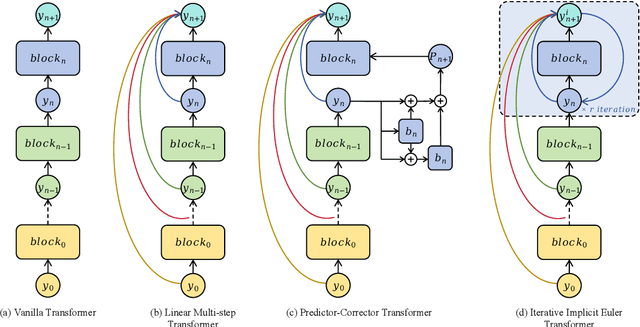
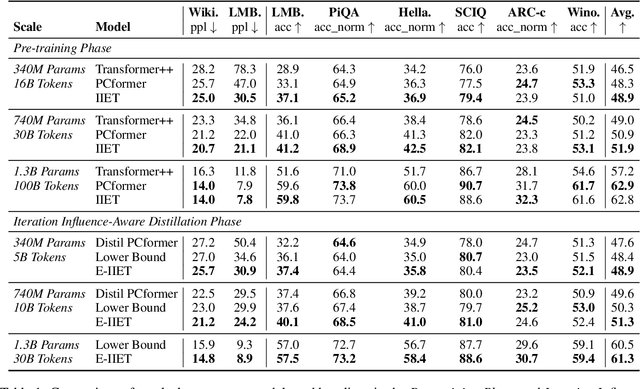
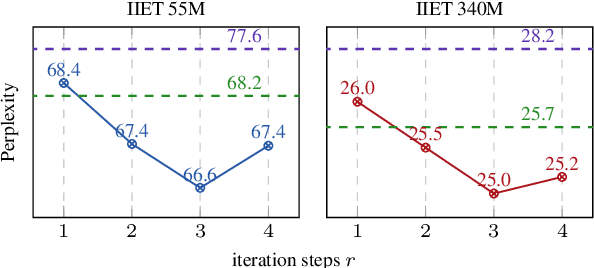

Abstract:High-order numerical methods enhance Transformer performance in tasks like NLP and CV, but introduce a performance-efficiency trade-off due to increased computational overhead. Our analysis reveals that conventional efficiency techniques, such as distillation, can be detrimental to the performance of these models, exemplified by PCformer. To explore more optimizable ODE-based Transformer architectures, we propose the \textbf{I}terative \textbf{I}mplicit \textbf{E}uler \textbf{T}ransformer \textbf{(IIET)}, which simplifies high-order methods using an iterative implicit Euler approach. This simplification not only leads to superior performance but also facilitates model compression compared to PCformer. To enhance inference efficiency, we introduce \textbf{I}teration \textbf{I}nfluence-\textbf{A}ware \textbf{D}istillation \textbf{(IIAD)}. Through a flexible threshold, IIAD allows users to effectively balance the performance-efficiency trade-off. On lm-evaluation-harness, IIET boosts average accuracy by 2.65\% over vanilla Transformers and 0.8\% over PCformer. Its efficient variant, E-IIET, significantly cuts inference overhead by 55\% while retaining 99.4\% of the original task accuracy. Moreover, the most efficient IIET variant achieves an average performance gain exceeding 1.6\% over vanilla Transformer with comparable speed.
TCPO: Thought-Centric Preference Optimization for Effective Embodied Decision-making
Sep 10, 2025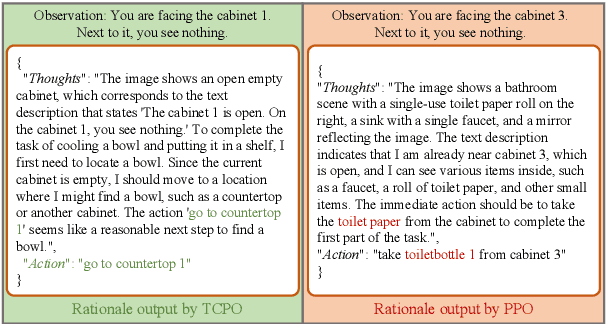

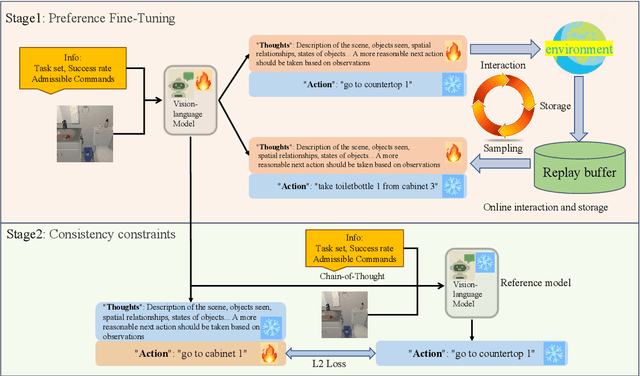

Abstract:Using effective generalization capabilities of vision language models (VLMs) in context-specific dynamic tasks for embodied artificial intelligence remains a significant challenge. Although supervised fine-tuned models can better align with the real physical world, they still exhibit sluggish responses and hallucination issues in dynamically changing environments, necessitating further alignment. Existing post-SFT methods, reliant on reinforcement learning and chain-of-thought (CoT) approaches, are constrained by sparse rewards and action-only optimization, resulting in low sample efficiency, poor consistency, and model degradation. To address these issues, this paper proposes Thought-Centric Preference Optimization (TCPO) for effective embodied decision-making. Specifically, TCPO introduces a stepwise preference-based optimization approach, transforming sparse reward signals into richer step sample pairs. It emphasizes the alignment of the model's intermediate reasoning process, mitigating the problem of model degradation. Moreover, by incorporating Action Policy Consistency Constraint (APC), it further imposes consistency constraints on the model output. Experiments in the ALFWorld environment demonstrate an average success rate of 26.67%, achieving a 6% improvement over RL4VLM and validating the effectiveness of our approach in mitigating model degradation after fine-tuning. These results highlight the potential of integrating preference-based learning techniques with CoT processes to enhance the decision-making capabilities of vision-language models in embodied agents.
SageLM: A Multi-aspect and Explainable Large Language Model for Speech Judgement
Aug 28, 2025Abstract:Speech-to-Speech (S2S) Large Language Models (LLMs) are foundational to natural human-computer interaction, enabling end-to-end spoken dialogue systems. However, evaluating these models remains a fundamental challenge. We propose \texttt{SageLM}, an end-to-end, multi-aspect, and explainable speech LLM for comprehensive S2S LLMs evaluation. First, unlike cascaded approaches that disregard acoustic features, SageLM jointly assesses both semantic and acoustic dimensions. Second, it leverages rationale-based supervision to enhance explainability and guide model learning, achieving superior alignment with evaluation outcomes compared to rule-based reinforcement learning methods. Third, we introduce \textit{SpeechFeedback}, a synthetic preference dataset, and employ a two-stage training paradigm to mitigate the scarcity of speech preference data. Trained on both semantic and acoustic dimensions, SageLM achieves an 82.79\% agreement rate with human evaluators, outperforming cascaded and SLM-based baselines by at least 7.42\% and 26.20\%, respectively.
One Size Does Not Fit All: A Distribution-Aware Sparsification for More Precise Model Merging
Aug 08, 2025Abstract:Model merging has emerged as a compelling data-free paradigm for multi-task learning, enabling the fusion of multiple fine-tuned models into a single, powerful entity. A key technique in merging methods is sparsification, which prunes redundant parameters from task vectors to mitigate interference. However, prevailing approaches employ a ``one-size-fits-all'' strategy, applying a uniform sparsity ratio that overlooks the inherent structural and statistical heterogeneity of model parameters. This often leads to a suboptimal trade-off, where critical parameters are inadvertently pruned while less useful ones are retained. To address this limitation, we introduce \textbf{TADrop} (\textbf{T}ensor-wise \textbf{A}daptive \textbf{Drop}), an adaptive sparsification strategy that respects this heterogeneity. Instead of a global ratio, TADrop assigns a tailored sparsity level to each parameter tensor based on its distributional properties. The core intuition is that tensors with denser, more redundant distributions can be pruned aggressively, while sparser, more critical ones are preserved. As a simple and plug-and-play module, we validate TADrop by integrating it with foundational, classic, and SOTA merging methods. Extensive experiments across diverse tasks (vision, language, and multimodal) and models (ViT, BEiT) demonstrate that TADrop consistently and significantly boosts their performance. For instance, when enhancing a leading merging method, it achieves an average performance gain of 2.0\% across 8 ViT-B/32 tasks. TADrop provides a more effective way to mitigate parameter interference by tailoring sparsification to the model's structure, offering a new baseline for high-performance model merging.
Safe Deployment of Offline Reinforcement Learning via Input Convex Action Correction
Jul 30, 2025Abstract:Offline reinforcement learning (offline RL) offers a promising framework for developing control strategies in chemical process systems using historical data, without the risks or costs of online experimentation. This work investigates the application of offline RL to the safe and efficient control of an exothermic polymerisation continuous stirred-tank reactor. We introduce a Gymnasium-compatible simulation environment that captures the reactor's nonlinear dynamics, including reaction kinetics, energy balances, and operational constraints. The environment supports three industrially relevant scenarios: startup, grade change down, and grade change up. It also includes reproducible offline datasets generated from proportional-integral controllers with randomised tunings, providing a benchmark for evaluating offline RL algorithms in realistic process control tasks. We assess behaviour cloning and implicit Q-learning as baseline algorithms, highlighting the challenges offline agents face, including steady-state offsets and degraded performance near setpoints. To address these issues, we propose a novel deployment-time safety layer that performs gradient-based action correction using input convex neural networks (PICNNs) as learned cost models. The PICNN enables real-time, differentiable correction of policy actions by descending a convex, state-conditioned cost surface, without requiring retraining or environment interaction. Experimental results show that offline RL, particularly when combined with convex action correction, can outperform traditional control approaches and maintain stability across all scenarios. These findings demonstrate the feasibility of integrating offline RL with interpretable and safety-aware corrections for high-stakes chemical process control, and lay the groundwork for more reliable data-driven automation in industrial systems.
GRAM: A Generative Foundation Reward Model for Reward Generalization
Jun 18, 2025Abstract:In aligning large language models (LLMs), reward models have played an important role, but are standardly trained as discriminative models and rely only on labeled human preference data. In this paper, we explore methods that train reward models using both unlabeled and labeled data. Building on the generative models in LLMs, we develop a generative reward model that is first trained via large-scale unsupervised learning and then fine-tuned via supervised learning. We also show that by using label smoothing, we are in fact optimizing a regularized pairwise ranking loss. This result, in turn, provides a new view of training reward models, which links generative models and discriminative models under the same class of training objectives. The outcome of these techniques is a foundation reward model, which can be applied to a wide range of tasks with little or no further fine-tuning effort. Extensive experiments show that this model generalizes well across several tasks, including response ranking, reinforcement learning from human feedback, and task adaptation with fine-tuning, achieving significant performance improvements over several strong baseline models.
TACTIC: Translation Agents with Cognitive-Theoretic Interactive Collaboration
Jun 11, 2025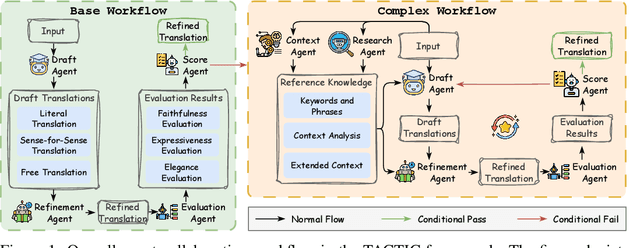
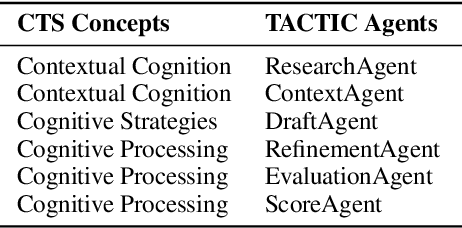
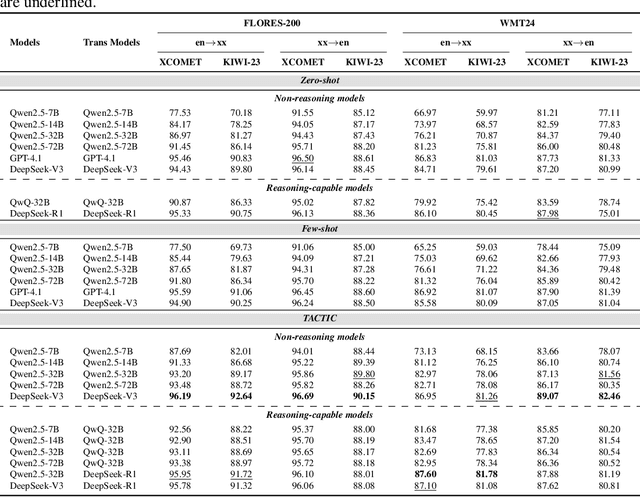
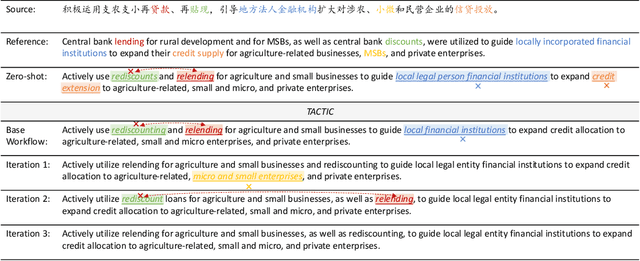
Abstract:Machine translation has long been a central task in natural language processing. With the rapid advancement of large language models (LLMs), there has been remarkable progress in translation quality. However, fully realizing the translation potential of LLMs remains an open challenge. Recent studies have explored multi-agent systems to decompose complex translation tasks into collaborative subtasks, showing initial promise in enhancing translation quality through agent cooperation and specialization. Nevertheless, existing multi-agent translation frameworks largely neglect foundational insights from cognitive translation studies. These insights emphasize how human translators employ different cognitive strategies, such as balancing literal and free translation, refining expressions based on context, and iteratively evaluating outputs. To address this limitation, we propose a cognitively informed multi-agent framework called TACTIC, which stands for T ranslation A gents with Cognitive- T heoretic Interactive Collaboration. The framework comprises six functionally distinct agents that mirror key cognitive processes observed in human translation behavior. These include agents for drafting, refinement, evaluation, scoring, context reasoning, and external knowledge gathering. By simulating an interactive and theory-grounded translation workflow, TACTIC effectively leverages the full capacity of LLMs for high-quality translation. Experimental results on diverse language pairs from the FLORES-200 and WMT24 benchmarks show that our method consistently achieves state-of-the-art performance. Using DeepSeek-V3 as the base model, TACTIC surpasses GPT-4.1 by an average of +0.6 XCOMET and +1.18 COMETKIWI-23. Compared to DeepSeek-R1, it further improves by +0.84 XCOMET and +2.99 COMETKIWI-23. Code is available at https://github.com/weiyali126/TACTIC.
 Add to Chrome
Add to Chrome Add to Firefox
Add to Firefox Add to Edge
Add to Edge